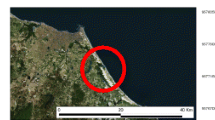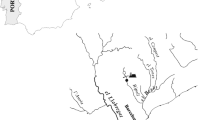Abstract
Sediment constitutes an important sink of endocrine disruptor compounds; however, the potential of sediments to act as a source of endocrine disruptors should be more extensively investigated. The main objective of this study was to determine whether exposure of immature common carp to Uruguay River sediments undergo physiological and endocrine alterations. The lower Uruguay River watershed supports intensive agricultural and forest production, receives municipal sewage discharge and industrial effluent, and a new large pulp mill was constructed in 2006. A 30-day semi-static assay was performed using sediments from four sites along the Uruguay River and compared with an unexposed group in dechlorinated water as a negative control. We focused on two upstream and two downstream sites of a new elemental chlorine free pulp mill. The results showed that plasma vitellogenin levels increased in fish along the river and significant differences were found between the exposed and unexposed groups. Condition factor and gonadosomatic index were not different; however, a significant difference in hepatosomatic index was observed in fish exposed to sediment from an industrial site. A significant reduction in primary spermatocyte accumulation was observed in the exposed group compared with that in the control group, and some individuals exposed to sediments from industrial sites presented with testis–ova. Our results suggest that Uruguay River sediments act as an important source of estrogenic compounds that could be responsible for the alterations observed. Future studies are needed to identify the causal agents and determine exposure routes.



Similar content being viewed by others
References
Céspedes-Payret C, Pineiro G, Achkar M et al (2009) The irruption of new agro-industrial technologies in Uruguay and their environmental impacts on soil, water supply and biodiversity: a review. Int J Environ Health 3:175–197. doi:10.1504/IJENVH.2009.024877
Devlin RH, Nagahama Y (2002) Sex determination and sex differentiation in fish: an overview of genetic, physiological, and environmental influences. Aquaculture 208:191–364. doi:10.1016/S0044-8486(02)00057-1
Gimeno S, Komen H, Gerritsen AGM, Bowmer T (1998) Feminisation of young males of the common carp, Cyprinus carpio, exposed to 4-tert-pentylphenol during sexual differentiation. Aquat Toxicol 43:77–92. doi:10.1016/S0166-445X(98)00056-3
Hutchinson TH, Ankley GT, Segner H, Tyler CR (2006) Screening and testing for endocrine disruption in fish-biomarkers as “signposts”, not “traffic lights”, in risk assessment. Environ Health Perspect 114:106–114. doi:10.1289/ehp.8062
Jessick AM, Skolness S, Kolok AS (2014) Sandy sediment and the bioavailability of 17β-trenbolone to adult female fathead minnows. Aquat Toxicol 148:48–54. doi:10.1016/j.aquatox.2013.12.025
Jobling S, Sumpter JP, Sheahan D et al (1996) Inhibition of testicular growth in rainbow trout (Oncorhynchus mykiss) exposed to estrogenic alkylphenolic chemicals. Environ Toxicol Chem 15:194–202. doi:10.1002/etc.5620150218
Jobling S, Nolan M, Tyler CR et al (1998) Widespread sexual disruption in wild fish. Environ Sci Technol 32:2498–2506. doi:10.1021/es9710870
Kolok AS, Snowc DD, Kohnod S et al (2007) Occurrence and biological effect of exogenous steroids in the Elkhorn River, Nebraska, USA. Sci Total Environ 388:104–115. doi:10.1016/j.scitotenv.2007.08.001
Kolpin DW, Blazer VS, Gray JL et al (2013) Chemical contaminants in water and sediment near fish nesting sites in the Potomac River basin: determining potential exposures to smallmouth bass (Micropterus dolomieu). Sci Total Environ 443:700–716. doi:10.1016/j.scitotenv.201209063
Miguez D, Carrara MV, Carnikián A et al (2010) Evaluación ecotoxicológica de sedimentos en una zona del Río Uruguay con puntos finales indicadores de toxicidad aguda, sub-letal, crónica, reproductiva y teratogénica. INNOTEC 5:3–10
Mnif W, Hassine AIH, Bouaziz A et al (2011) Effect of endocrine disruptor pesticides: a review. Int J Environ Res Public Health 8:2265–2303. doi:10.3390/ijerph8062265
Munkittrick KR, McMaster ME, Portt CB et al (1992) Changes in maturity, plasma sex steroid levels, hepatic mixed-function oxygenase activity, and the presence of external lesions in lake whitefish (Coregonus clupeaformis) exposed to bleached kraft mill effluent. Can J Fish Aquat Sci 49:1560–1569. doi:10.1139/f92-173
Ng Y, Hanson S, Malison JA et al (2006) Genistein and other isoflavones found in soybeans inhibit estrogen metabolism in salmonid fish. Aquaculture 254:658–665. doi:10.1016/j.aquaculture.2005.10.039
Nilsen BM, Berg K, Eidem JK et al (2004) Development of quantitative vitellogenin-ELISAs for fish test species used in endocrine disruptor screening. Anal Bioanal Chem 378:621–633. doi:10.1007/s00216-003-2241-2
Orrego R, Moraga-Cid G, González M et al (2005) Reproductive, physiological, and biochemical responses in juvenile female rainbow trout (Oncorhynchus mykiss) exposed to sediment from pulp and paper mill industrial discharge areas. Environ Toxicol Chem 24:1935–1943. doi:10.1897/04-251R1.1
Paruelo JM, Guerschman JP, Piñeiro G et al (2006) Cambios en el uso de la tierra en Argentina y Uruguay: marcos conceptuales para su análisis. Agrociencia 10(2):47–61
Peck M, Gibson RW, Kortenkamp A, Hill EM (2004) Sediments are major sinks of steroidal estrogens in two United Kingdom rivers. Environ Toxicol Chem 23:945–952. doi:10.1897/03-41
Saizar C, Boccardi L, Clemente J et al (2010) Línea de base para evaluar el impacto de una planta de celulosa en el Río Uruguay. INNOTEC 5:11–22
Sellin MK, Snow DD, Schwarz M et al (2009) Agrochemicals in Nebraska, USA, watersheds: occurrence and endocrine effects. Environ Toxicol Chem 28:2443–2448. doi:10.1897/09-135.1
Sellin MK, Snow DD, Kolok AS (2010) Reductions in hepatic vitellogenin and estrogen receptor alpha expression by sediments from an agriculturally impacted waterway. Aquat Toxicol 96:103–108. doi:10.1016/j.aquatox.2009.10.004
Sellin MK, Abbott K, Cowman T et al (2011a) Occurrence and endocrine effects of agrichemicals in a small Nebraska, USA, watershed. Environ Toxicol Chem 30(10):2253–2260. doi:10.1002/etc.615
Sellin MK, Conoan NH, Cox MB et al (2011b) The anti-estrogenic activity of sediments from agriculturally intense watersheds: assessment using in vivo and in vitro assays. Aquat Toxicol 105:189–198. doi:10.1016/j.aquatox.2011.04.008
Smith BB, Walker KF (2004) Spawning dynamics of common carp in the River Murray, South Australia, shown by macroscopic and histological staging of gonads. J Fish Biol 64:336–354. doi:10.1111/j.0022-1112.2004.00293.x
Vega E, Baldi G, Jobbágy EG, Paruelo J (2009) Land use change patterns in the Río de la Plata grasslands: the influence of phytogeographic and political boundaries. Agric Ecosyst Environ 134:287–292. doi:10.1016/j.agee.2009.07.011
Velisek J, Stara A, Kolarova J et al (2011) Biochemical, physiological and morphological responses in common carp (Cyprinus carpio L.) after long-term exposure to terbutryn in real environmental concentration. Pestic Biochem Physiol 100:305–313. doi:10.1016/j.pestbp.2011.05.004
Acknowledgments
We express our thanks to the Departments of Virology and Cellular Biology (Science School) for cooperation with the processing of samples and to Mr. Angel Rosano and the Uruguayan Navy for their assistance in the fieldwork. This study was funded by the National Agricultural Research Institute (INIA) Project SA07 and the Environmental Science Master Program.
Conflict of interest
None.
Author information
Authors and Affiliations
Corresponding author
Rights and permissions
About this article
Cite this article
Rivas-Rivera, N., Eguren, G., Carrasco-Letelier, L. et al. Screening of endocrine disruption activity in sediments from the Uruguay River. Ecotoxicology 23, 1137–1142 (2014). https://doi.org/10.1007/s10646-014-1244-4
Accepted:
Published:
Issue Date:
DOI: https://doi.org/10.1007/s10646-014-1244-4




